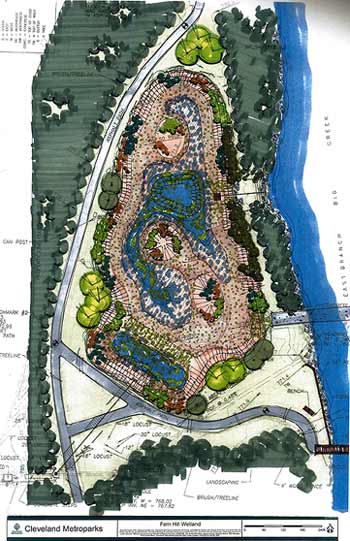

A stormwater treatment wetland was proposed in the Big Creek Reservation located at the Fern Hill Picnic Area within the City of Parma just east of Hauserman Road and south of Brookpark Road. The 50.8 acre drainage area to the site is predominantly a residential area. The watershed is 30 percent impervious.
The proposed project site was, at the time, used as a passive recreational area and consisted of a large field, all-purpose trail and unmaintained volleyball court. Directly across the stream on the east bank is a heavily used recreational facility and parking lot. A pedestrian bridge across Big Creek connects the two banks. Discussions with Cleveland Metroparks staff indicated the proposed area was underutilized.
The project consisted of a 0.77-acre pretreatment cell and stormwater wetland (BMP) to provide treatment for a 50-acre watershed that was currently untreated. Stormwater runoff from the residential, 30% impervious area currently outlet directly into Big Creek through an outfall. Conceptual plans developed by Tetra Tech, Inc. on behalf of BCC (then Friends of Big Creek) formed the basis of final design plans which were then prepared by Cleveland Metroparks for the stormwater treatment wetland.
The original conceptual plans for the project included constructing a flow diverter within the existing storm sewer system to divert storm runoff to the BMP. Remaining stormwater would then routed back into the existing storm sewer and discharged at the current storm sewer outfall along Big Creek. The pretreatment cell would be approximately 3-4 feet deep and include energy dissipation for the diverted flow, which would be vegetated with native grasses and forbs. The wetland would include 18 inches of ponded depth. A one-foot soil amendment was proposed for the wetland area.
To facilitate ease of maintenance, a trail was to be located on all three sides of the triangular shaped pretreatment cell, and three of the four sides of the proposed wetland. In coordination with Cleveland Metroparks, the proposed trail would be designed to current Cleveland Metroparks trail standards, which are sufficient to allow for routine vehicle access.
Native plants include:
Asclepias incarnate (Swamp milkweed)
Rosa palustris (Swamp rose)
Mimulus ringens (Monkeyflower)
Eupatorium maculatum (Joe Pye weed)
Iris versicolor (Blue flag)
Lobelia cardinalis (Cardinal flower)
Lobelia siphilitica (Great blue lobelia)
Verbena hastate (Blue vervain)
Complete list
The pretreatment cell was to be designed with material that will dissipate energy from the inflow and provide access for routine maintenance. A diverse selection of native plants would be planted within the pretreatment cell and wetland to improve water quality performance, minimize invasive species, and attract preferred local fauna. The 0.77-acre project site would provide 100% of the water quality volume and 0.06 acre-ft of additional flood control volume.
Actualized Plan - Cleveland Metroparks
 Modifications to the conceptual plans included:
Modifications to the conceptual plans included:
No separate pretreatment cell in the triangle surrounded by the trail. Instead the pretreatment (forebay) located on the other side of that triangle.
Water does not go back into the storm sewer, but rather, goes through an outlet structure to the east of the temporary settling area (to the north).